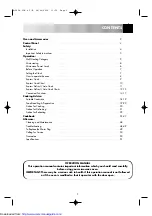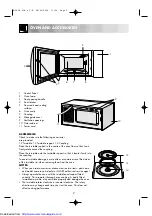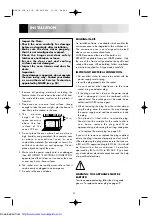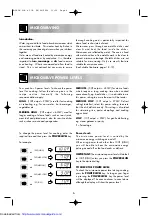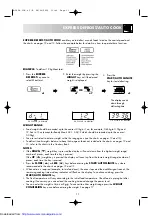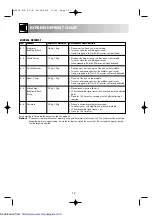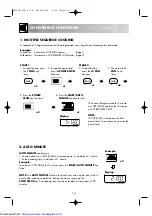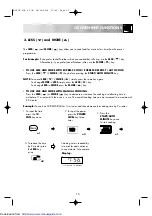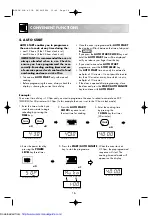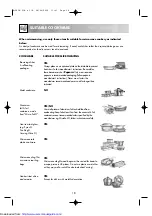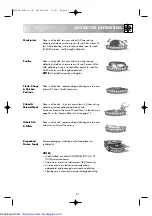
6
MICROWAVING
MICROWAVE POWER LEVELS
Introduction:
Water, sugar and fat in food absorb microwaves which
causes them to vibrate. This creates heat by friction, in
the same way your hands get warm when you rub them
together.
Outer areas of food are heated by microwave energy,
and remaining portions by conduction. It is, therefore,
important to
turn
,
rearrange
or
stir
food to ensure
even heating. Where recommended allow food to
stand. This is not optional but necessary to ensure
thorough cooking and is particularly important for
dense food, such as joints of meat.
Microwaves pass through non-metallic dishes and
utensils and heat the food inside the dishes.
Microwaves are reflected by metal. The oven is lined
with metal and has a fine metallic mesh in the door to
prevent microwave leakage. Metallic dishes are not
suitable for microwaving. Only use utensils that are
suitable for microwave ovens.
(See Suitable Cookware, pages 18 - 19).
Power level:
The microwave power level is varied by the
microwave energy switching on and off.
When using power levels other than 100P (HIGH)
you will be able to hear the microwave energy
pulsing on and off as the food cooks or defrosts.
IMPORTANT:
The microwave power level will default
to 100P (HIGH) unless you press the
POWER LEVEL
key to the desired setting.
TO CHECK THE POWER LEVEL:
To check the microwave power level during cooking,
press the
POWER LEVEL
key. As long as your finger
is pressing the
POWER LEVEL
key the power level
will be displayed. The oven continues to count down
although the display will show the power level.
To change the power level for cooking, enter the
required time and then press the
POWER LEVEL
key.
For example:
Your oven has 5 power levels. To choose the power
level for cooking, follow the advice given in the
recipe section. Generally the following
recommendations apply:
HIGH
- (100P output = 900W) used for fast cooking
or reheating e.g. for casseroles, hot beverages,
vegetables etc.
MEDIUM HIGH
- (70P output = 630W) used for
longer cooking of dense foods such as roast joints,
meat loaf and plated meals, also for sensitive dishes
such as cheese sauce and sponge cakes.
MEDIUM
- (50P output = 450W) for dense foods
which require a long cooking time when cooked
conventionally, eg. beef dishes, it is advisable to use
this power setting to ensure the meat will be tender.
MEDIUM LOW
- (30P output = 270W Defrost
setting) to defrost, select this power setting, to ensure
that the dish defrosts evenly. This setting is also ideal
for simmering rice, pasta, dumplings and cooking
egg custard.
LOW
- (10P output = 90W) For gentle defrosting,
eg. cream gateaux or pastry.
P = Percentage
POWER
LEVEL
POWER
LEVEL
POWER
LEVEL
POWER
LEVEL
POWER
LEVEL
x1
100P (HIGH)
KG•LB
TURN
STIR
PCS MICRO COOK
x2
70P (MED HIGH)
KG•LB
TURN
STIR
PCS MICRO COOK
x3
50P (MEDIUM)
KG•LB
TURN
STIR
PCS MICRO COOK
x4
30P (MED LOW)
KG•LB
TURN
STIR
PCS MICRO COOK
x5
10P (LOW)
KG•LB
TURN
STIR
PCS MICRO COOK
R-383M O/M & C/B 28/04/2000 11:39 Page 6
http://www.usersmanualguide.com/
Summary of Contents for R-383M
Page 2: ...R 383M O M C B 28 04 2000 11 39 Page B Downloaded from http www usersmanualguide com ...
Page 54: ...R 383M O M C B 28 04 2000 11 43 Page 52 Downloaded from http www usersmanualguide com ...
Page 55: ...R 383M O M C B 28 04 2000 11 43 Page 53 Downloaded from http www usersmanualguide com ...



